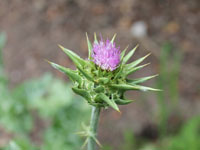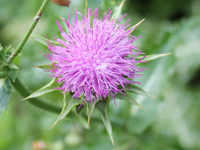![]()
Blessed Milk Thistle, also known as Marian Thistle, Mary Thistle, Saint Mary's Thistle, and variegated thistle, is an annual or biennial plant of the Aster family. Blessed Milk Thistle originally is a native species of Southern Europe through to Asia, it is now found throughout the world and is very common. Blessed Milk thistle gets its name from the milky sap that comes out of the leaves when they are broken. The leaves also have unique white markings that, according to legend, were the Virgin Mary’s milk.
![]()
Milk thistle is used most often for liver disorders, including liver damage caused by chemicals, Amanita phalloides mushroom poisoning, jaundice, chronic inflammatory liver disease, cirrhosis of the liver, and chronic hepatitis. Nevertheless, researchers have not yet concluded with certainty that blessed milk thistle is effective for any of these uses. Cultivated fields for the production of raw material for the pharmaceutical industry exist on a larger scale in Austria, Germany, Hungary, Poland, China and Argentina. In Europe, blessed milk thistle, is sown yearly in March and April. The harvest in two steps (cutting and threshing) takes place in August, about 2 to 3 weeks after the plant has flowered.
![]() Within the realm of naturopathic medicine and folklore, blessed milk thistle has a long history of use in North America and Europe as a remedy for depression and liver problems. Blessed Milk Thistle has also been used as a food source and the roasted seeds were used as a coffee substitute.
Within the realm of naturopathic medicine and folklore, blessed milk thistle has a long history of use in North America and Europe as a remedy for depression and liver problems. Blessed Milk Thistle has also been used as a food source and the roasted seeds were used as a coffee substitute.
Please note that MIROFOSS does not suggest in any way that plants should be used in place of proper medical and psychological care. This information is provided here as a reference only.
![]()
Blessed Milk Thistle is considered edible. A mild flavour and somewhat mucilaginous texture when boiled, the roots resemble salsify. The leaves of blessed milk thistle, raw or cooked, must have the very sharp leaf-spines removed before consumption.
Please note that MIROFOSS can not take any responsibility for any adverse effects from the consumption of plant species which are found in the wild. This information is provided here as a reference only.
![]()
Blessed Milk Thistle, like many other plants in the genus Silybum, are native to Eurasia and northern Africa. Blessed Milk Thistle is suitable for: light (sandy), medium (loamy) and heavy (clay) soils and prefers well-drained soil. Suitable pH: acid, neutral and basic (alkaline) soils and can grow in very alkaline soils. Blessed Milk Thistle cannot grow in the shade and it prefers dry or moist soil. The plant can tolerates strong winds but not maritime exposure.
| Soil Conditions | |
| Soil Moisture | |
| Sunlight | |
| Notes: |
![]()
Blessed Milk Thistle can grow from 30cm to 200cm tall with an overall conical plant shape. The stem of the blessed milk thistle is grooved and more or less cotton like with the largest specimens; The stem will become hollow. The leaves of the blessed milk thistle are oblong to lanceolate. They are either lobate or pinnate, with spiny edges. They are hairless, shiny green, with milk-white veins that when broken produce a milky white sap. The flower heads are 4cm to 12cm long and wide and are red to purple in colour. Blessed Milk Thistle is in bloom from June to August in the Northern Hemisphere or December to February in the Southern Hemisphere. The flowers are hermaphrodite (have both male and female organs) and are pollinated by bees. The seeds of the blessed milk thistle are black with a simple long white pappus surrounded by a yellow basal ring.
![]()
| Plant Height | 30cm to 200cm | 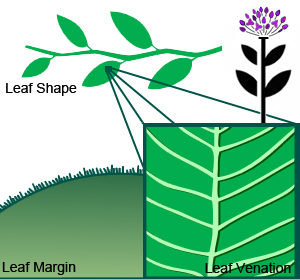 |
| Habitat | Waste Places, Rocky Soil | |
| Leaves | Oblong to lanceolate, either lobate or pinnate, with spiny edges | |
| Leaf Margin | Ciliate | |
| Leaf Venation | Pinnately lobed | |
| Stems | Grooved and more or less cottony. | |
| Flowering Season | June to August | |
| Flower Type | Rounded clusters of ray less flowers | |
| Flower Colour | violet, vary rarely red | |
| Pollination | Bees | |
| Flower Gender | Flowers are hermaphrodite | |
| Fruit | Small silky tufts carried by wind | |
| USDA Zone | 5A (-26.2°C to -28.8°C) cold weather limit |
![]()
The following health hazards should be noted when handling or choosing a location to plant blessed milk thistle:
 |
SHARP HAZARD Thistles contain small sharp thorns which can be painful if incorrectly handled. |
 |
POSSIBLE TOXICITY When grown on nitrogen rich soils, especially those that have been fed with chemical fertilizers, this plant can concentrate nitrates in the leaves. Nitrates are implicated in stomach cancers. Diabetics should monitor blood glucose when using. Possible headaches, nausea, irritability and minor gastrointestinal upset can occur after ingesting. |
 |
ENVIRONMENTAL HAZARD Because of potassium nitrate content, the plant has been found to be toxic to cattle and sheep. When potassium nitrate is eaten by ruminants, the bacteria in an animal's stomach break the chemical down, producing a nitrite ion. Nitrite ion then combines with hemoglobin to produce methaemoglobin, blocking the transport of oxygen. The result is a form of oxygen deprivation. |
![]()
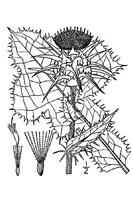 |
-Click here- or on the thumbnail image to see an artist rendering, from The United States Department of Agriculture, of blessed milk thistle. (This image will open in a new browser tab) |
![]()
 |
-Click here- or on the thumbnail image to see a magnified view, from The Canadian Food Inspection Agency, of the seeds created by the blessed milk thistle for propagation. (This image will open in a new browser tab) |
![]()
Blessed Milk Thistle can be referenced in certain current and historical texts under the following six names:
Blessed Milk Thistle can be translated into the following select languages:
| Arabic | المبارك الحليب الشوك | Bulgarian | Блажен млякомагарешки бодил | Chinese (Sim) | 祝福奶蓟 |
| Croatian | Blago mlijeko čičak | Czech | požehnané Ostropestřec mariánský | Danish | velsignede mælk tidsel |
| Dutch | Gezegend melkdistel | Esperanto | benitan lakto prunelon | Estonian | õnnistatud piima ohakas |
| Finnish | French | chardon béni | German | Mariendistel | |
| Greek | Ευλογημένος γαϊδουράγκαθο | Hebrew | גדילן מצויה לברכה | Hungarian | áldott bogáncs |
| Italian | Beato latte cardo | Japanese | 祝福オオアザミ | Korean | 축복 엉겅퀴 |
| Low Saxon | Lithuanian | palaimintosios pieno usnis | Norwegian | velsignet melk tistel | |
| Persian | خوشا به شیر خار | Polish | Błogosławiony Ostropest | Portuguese | cardo de leite abençoadas |
| Romanian | Ferice de lapte ciulin | Russian | благословенные Расторопша | Slovak | požehnanej Pestrec mariánsky |
| Spanish | Bendita leche cardo | Swedish | välsignade mjölktistel | Tagalog | tistle mapalad gatas |
| Turkish | Mübarek süt devedikeni | Ukrainian | благословенні Розторопша | Vietnamese | cây kế sữa phúc |

![]()
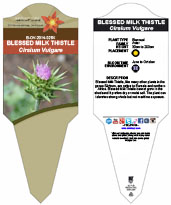 |
The MIROFOSS database offers free printable garden tags for personal and non-profit use. These tags can be used to properly identify plant samples in a garden. Click on the tags shown on the the screen or -click here- to download a full size jpeg image for a blessed milk thistle identification tag; which can be printed on paper or used with a plastic laser printer. |
 |
What's this? What can I do with it? |
![]()
| Description | Rose, Francis (1981). The Wild Flower Key. Frederick Warne. pp. 388–9. ISBN 0-7232-2419-6. |
| Folklore | Hogan, Fawn S.; Krishnegowda, Naveen K.; Mikhailova, Margarita; Kahlenberg, Morton S. (2007). "Flavonoid, Silibinin, Inhibits Proliferation and Promotes Cell-Cycle Arrest of Human Colon Cancer". Journal of Surgical Research 143 (1): 58–65. |
| Biology | Kroll, D. J.; Shaw, H. S.; Oberlies, N. H. (2007). "Milk Thistle Nomenclature: Why It Matters in Cancer Research and Pharmacokinetic Studies". Integrative Cancer Therapies 6 (2): 110–9. |
| Biology | Dickinson, T.; Metsger, D.; Bull, J.; & Dickinson, R. (2004) ROM Field Guide to Wildflowers of Ontario, Royal Ontario Museum, Toronto:McClelland and Stewart Ltd. |
| Environment | National Audubon Society. Field Guide To Wildflowers (Eastern Region): Alfred A. Knopf. ISBN 0-375-40232-2 |
| Physical Identification | National Audubon Society. Field Guide To Wildflowers (Eastern Region): Alfred A. Knopf. ISBN 0-375-40232-2 |
| January 31, 2015 | The last time this page was updated |
| ©2025 MIROFOSS™ Foundation | |
 |
|

